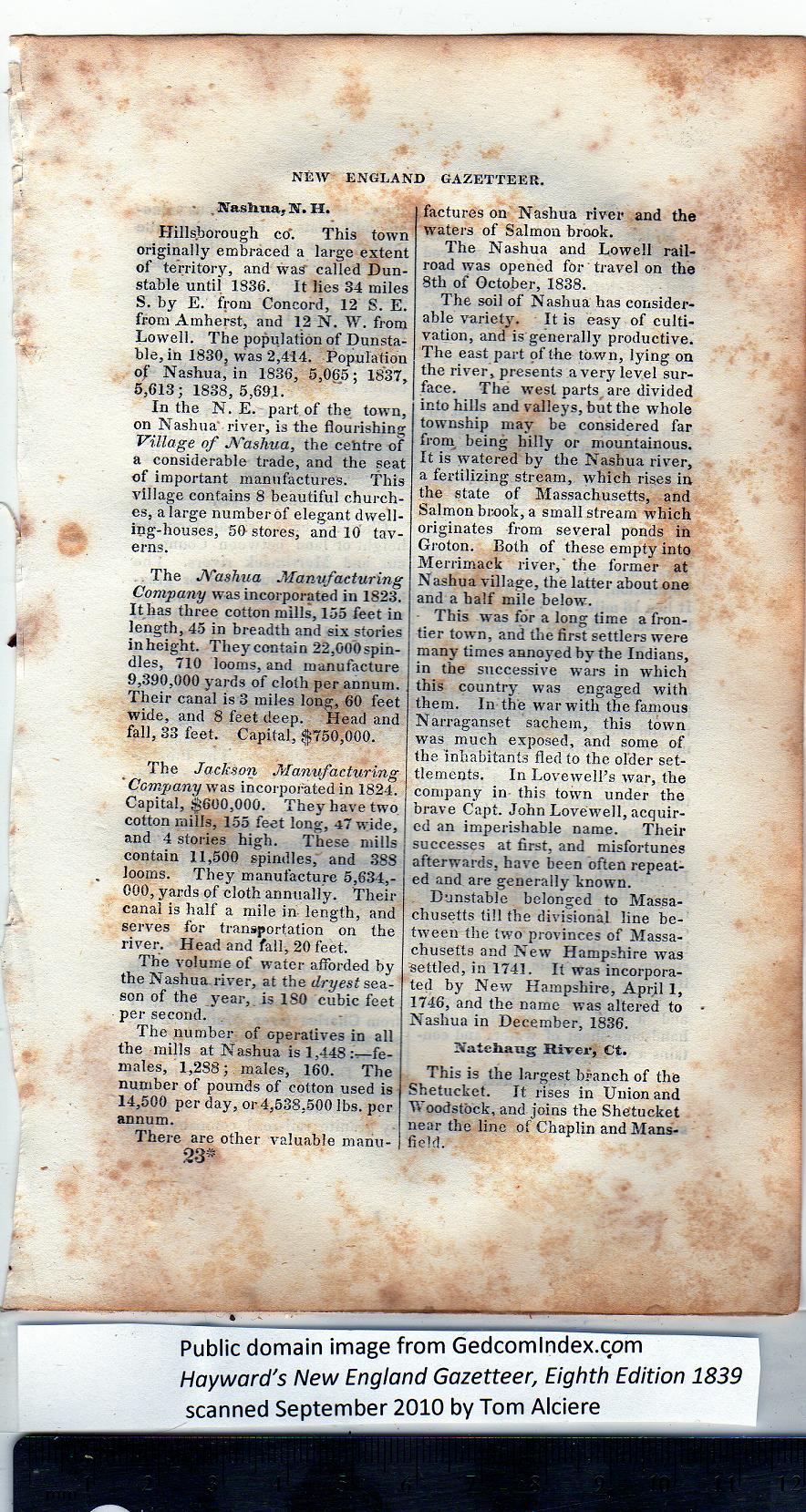|
Nashua, N. H.
Hillsborough co'. This town
originally embraced a large extent
of territory, and was called Dun-
stable until 1836. It lies 34 miles
S. by E. from Concord, 12 S. E.
from Amherst, and 12 N. W. from
Lowell. The population of Dunsta-
ble, in I830? was 2,414. Population
of Nashua, in 1836, 5,065; 1837,
5,613; 1838, 5,601.
In the N. E. part of the town,
on Nashua' river, is the flourishing
Village of Nashua, the cehtre of
a considerable trade, and the seat
of important manufactures. This
village contains 8 beautiful church-
es, a large number of elegant dwell-
ing-houses, 50 stores, and 10 tav-
erns.
The Nashua .Manufacturing
Company was incorporated in 1823.
It has three cotton mills, 155 feet in
length, 45 in breadth and six stories
inheight. They contain 22,000spin-
dles, 710 looms, and manufacture
9,390,000 yards of cloth per annum. .
Their canal is 3 miles long, 60 feet
wide, and 8 feet deep. Head and
fall, 33 feet. Capital, $750,000.
The Jackson Manufacturing
'Company was incorporated in 1824.
Capital, $600,000. They have two
cotton mills, 155 feet long, 47 wide,
and 4 stories high. These mills
contain 11,500 spindles, and 38S
looms. They manufacture 5,634,-
000, yards of cloth annually. Their
canal is half a mile in length, and
serves for transportation on the
river. Head and fall, 20 feet.
The volume of water afforded by
the Nashua river, at the dryest sea-
son of the year, is ISO cubic feet
per second.
The number of operatives in all
the mills at Nashua is 1,448 fe-
males, 1,288; males, 160. The
number of pounds of cotton used is
14,500 per day, or 4,538,500 lbs. per
annum.
There are other valuable mariu-
23* |
factures on Nashua river and the
waters of Salmon brook.
The Nashua and Lowell rail-
road was opened for travel on the
8th of October, 1838.
The soil of Nashua has consider-
able variety. It is easy of culti-
vation, and is generally productive.
The east part pf the town, lying on
the river, presents a very level sur-
face. The west parts are divided
into hills and valleys, but the whole
township may be considered far
from being hilly or mountainous.
It is watered by the Nashua river,
a fertilizing stream, which rises in
the state of Massachusetts, and
Salmon brook, a small stream which
originates from several ponds in
Groton. Both of these empty into
Merrimack river, the former at
Nashua village, the latter about one
and a half mile below.
This was for a long time a fron-
tier town, and the first settlers were
many times annoyed by the Indians,
in the successive wars in which
this country was engaged with
them. In the war with the famous
Narraganset sachem, this town
was much exposed, and some of
the inhabitants fled to the older set-
tlements. In Lovewell’s war, the
company in this town under the
brave Capt. John Lovewell, acquir-
ed an imperishable name. Their
successes at first, and misfortunes
afterwards, have been often repeat-
ed and are generally known.
Dunstable belonged to Massa-
chusetts till the divisional line be-
tween the two provinces of Massa-
chusetts and New Hampshire was
settled, in 1741. It was incorpora-
ted by New Hampshire, April 1,
1746, and the name was altered to
Nashua in December, 1836.
Natchaug River, Ct.
This is the largest branch of the
Shetucket. It rises in Union and
Woodstock, and joins the Shetucket
near the line of Chaplin and Mans-
field. |
